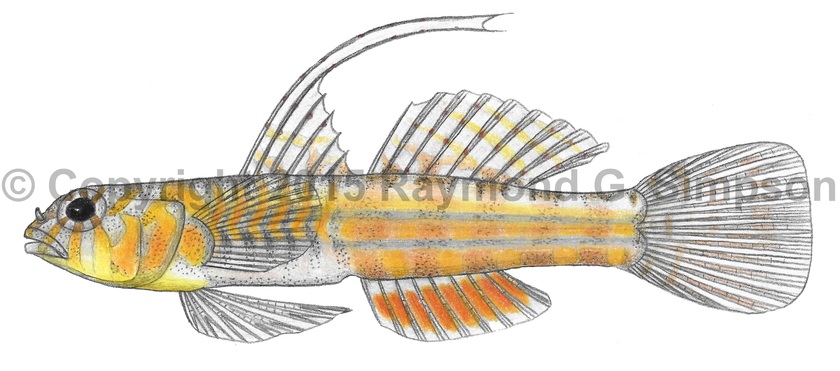
Common Name
Diphasic Goby
Year Described
Ginsburg, 1939
Identification
Dorsal Fin: VI, 9-11
Anal Fin: 8-10
Pectoral Fin: 13-16
Caudal Fin: 16-17
Lateral Line Scales: 23-25
Gill Rakers: 7 (first arch)
Vertebrae: 9+17 = 26 (total)
Body elongate and tapering to the rear. No lateral pores on head. Jaws with bands of teeth (conical teeth inward and sharp canines outside) but vomer and palatine without teeth. Anterior nostril tubular. Posterior nostril slightly raised and separated from anterior nostril. No frenum on upper lip. Tongue rounded at tip. Gill opening extends to ventral part of opercular flap. Head, chest, nape, and pectoral base naked. Naked area extends to origin of spiny dorsal fin. Belly naked. Two separate dorsal fins. Anterior dorsal fin spines elongate. Pectoral rays unbranched.
Color
Body with alternating bands of pale and dark orange. Two gray body stripes usually apparent on mid-side, becoming broken up near pectoral fin. Dorsum with gray blotches alternating with orange blotches. Head gray with orange spots and bands radiating from eyes. Lower head yellowish. Eye with orange stripes. Body bands extend onto dorsal fin as faint orange stripes. Distal portion with small blood red spots. Caudal fin clear with orange spots dorsally and orange rays basally. Anal fin clear with a median band of red-orange. Pectoral and pelvic fins clear.
Size
A tiny species reaching 25mm SL
Habitat
Found on shallow coral reefs from 1-16m
Range
The Bahamas to the S. Caribbean Sea
References
Böhlke, J. E. and C. R. Robins. 1960. Western Atlantic gobioid fishes of the genus Lythrypnus, with notes on Quisquilius hipoliti and Garmannia pallens. Proceedings of the Academy of Natural Sciences of Philadelphia v. 112: 73-101, Pls. 1-3.